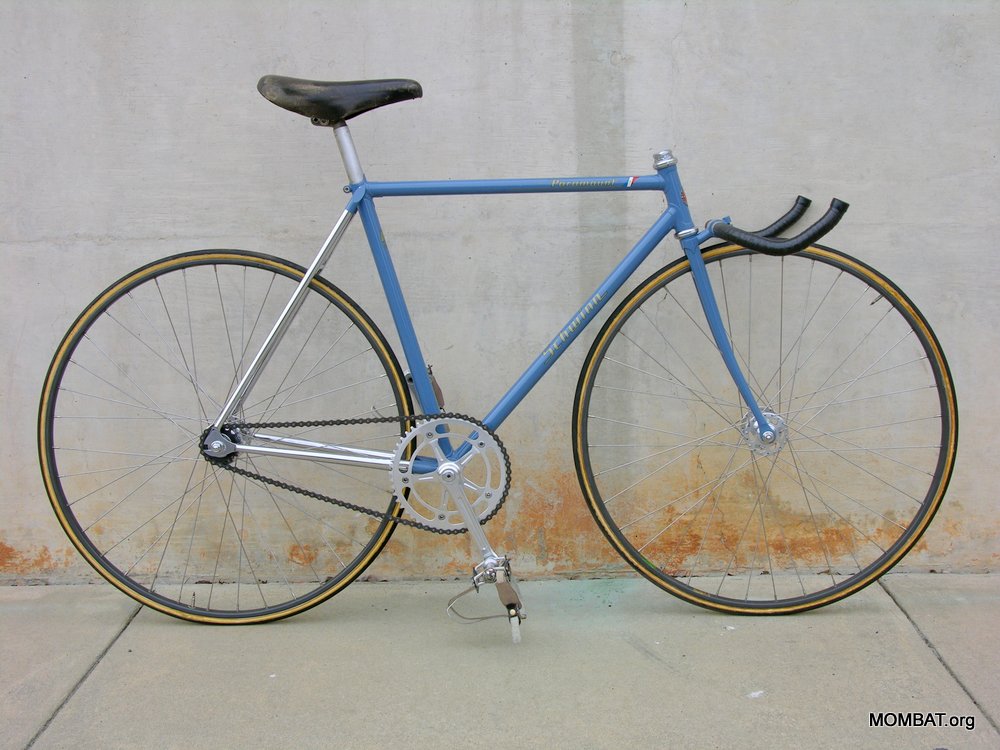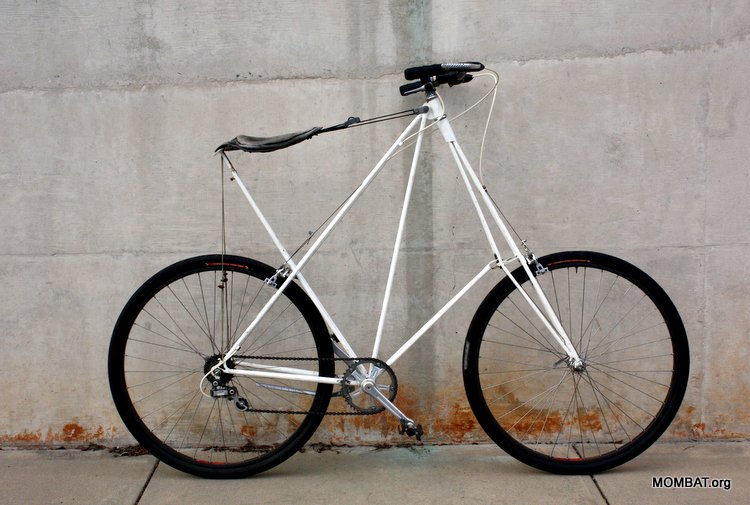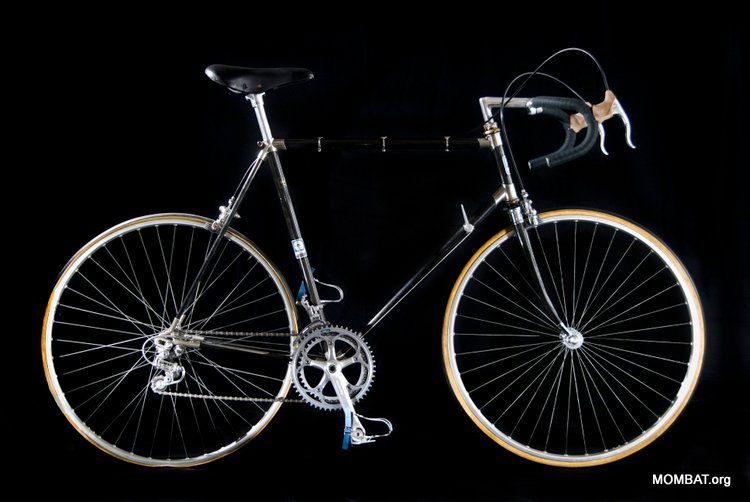Lightweight Bike Museum
Below are some pictures and
details of the lightweight bikes that we house as part of
the MOMBAT collection. These bikes are not for
sale. The bikes and parts we currently have for sale can
be found on the
MOMBAT for sale page.
Click on image to begin a slideshow of each bike.
Click on image to begin a slideshow of each bike.
 |
1984 Raleigh Olympic Bike, USA: The first generation of funny bikes were built for the 1983 Pan Am Games and 1984 Olympics (held in Los Angeles, CA). These radical bikes were designed and produced by Mike Melton in the Huffy Tech Center in Dayton, OH. They featured 24" wheels, crown mounted stems, internal roller bearing headsets, narrowed front hubs, Dura Ace AX aero seat post, flush mounted bolts and air-smoothing gussets. Very radical bikes at the time which won a variety of medals. More info can be found on the MOMBAT: Olympic Bike Page. |
 |
1982 Schwinn Paramount Elite: The Paramount had been the top Schwinn model since 1938 until it fell on hard times in the late 1970's. In the early 1980's, the Paramount Design Group was formed in Waterford, WI. As part of the renewal, they were willing to build just about anything the customer could envision. This is one of those experimental bikes. Most of the bike is a conventional bike with Campagnolo Pista (track) component group. The unique feature is the crown mounted handlebars which allowed the bars to be lower than would have been feasible with a traditional stem. |
 |
1987 Pedersen: The Pedersen design resembles a truss bridge and relies on 21 triangles of small tubing for strength. The hammock style seat is suspended by the trusses and, when combined with the upright seating position, is very comfortable Designed by Mikael Pedersen in the 1890's, it was made by several different companies until 1920 or so. The design was rediscovered in the 1970's and is currently still in production. |
|
|
1989 Schwinn Aeromount: This bike was built as a geometry test mule for the early 1990's Paramount OS 650 bikes. Since it was just a proof-of-concept, it was built with Tange Aero tubing and Tange Aero fork, even the chain stay bridge is airfoil shaped. The shifters are mounted to the top of the top tube and the hubs were prototype Dura Ace hubs with slotted holes for aero spokes. Seat post is the non-round Shimano Dura Ace AX. The bike uses 650 wheels front and rear with a 56 tooth big ring to compensate for the smaller wheels. The bike was built up with parts that were laying around the Waterford facility. The bike was very lightly used but it appears as if the paint prep was poor. There is a line of bubbles under the paint under the down tube and across the front of the head tube. Doesn't appear to be corrosion, just bad prep. |
|
|
1988 Schwinn Paramount: 50th Anniversary Paramount frame, Team Wheaties bike. The bike was ridden by Alan McCormack during the 1988 season. Serial number is McCormack and "The Leprechaun" is painted on the chain stay. The bike was stripped of its parts at one time and built up with stuff that was laying around the Waterford facility. Bike is very lightly used and is in great condition. Can't imagine there were too many of the actual team bikes made (much rarer than the regular 50 Anniversary frames with the gold forks). |

|
1978 Ritchey Road: We bought this one from the original owner who purchased the bike from a small magazine ad in the back of a cycling magazine. The bike is constructed with a mix of traditional lugs and fillet brazing. The frame is a 70cm (28") and has an 11.25" head tube (almost the same length as the seat tube on some extra small adult bikes!). Components appear to be mostly original and the bike never had Ritchey decals. |
|
|
1990 Profile For Speed Air Raid: Profile for Speed was mostly known for their bicycle parts but they did dabble in frames as well. Aegis had worked with Trek on some of their early carbon bikes and decided to go their own way due to some disagreements over construction techniques. They offered some private label frames to several companies including Profile. Nice looking frame with internal cable routing and a clean seat binder arrangement. Components are mostly Shimano 105 and 600 from the era. |

|
1974 Peugeot PX 10 LE: Catalog data - Appears to be the date of the introduction of the PX-10LE, which features plain Nervex lugs outlined in gold. Distinctive equipment includes Maillard 700 high-flange hubs; Cyclo 14-15-17-19-21T freewheel; Allen-key fitted Atax stem w/ Philippe bar; Mafac "Competition" brakes w/ half-hooded levers; and an Ideale 2001 saddle. The PX-10E is also listed. Features included Nervex Pro lugs, black at the head tube; Brooks B-17 or Ideale 90 saddle; the same freewheel as the LE model; Mafac "Racer" brakes; Simplex Criterium rear and Super Competition (parallelogram action) Delrin derailleurs; and otherwise identical components to earlier bikes. |
|
|
1992 Fat Chance Slim Chance: Chris Chance made road bikes under his own name prior to making mountain bikes. After the mountain bikes took off, road bikes were abandoned for a number of years until the Slim Chance made the scene. This one is equipped with the Shimano 600 STI group and is pretty clean. |
 |
1978 Red Bush tandem: The "Red Bush" name was used by Ross Shafer prior to switching over to the Salsa name. I can only imagine the number of hours that were spend smoothing all of the fillet work on this bike. After all of the hours spend with the fillets, there were many more spent on details such as the unique fork crown, fillet brazed stoker stem and hand made cantilever mounts. This bike was a spec bike built in 1978 or 79 and sat at the Bicycle Center for a couple of years before it was sold. . |
 |
1990 Trimble: The Trimble family had several members who were active in the cycling industry. Brent made mountain bikes, Roo made one piece bar stem combos and James made aerodynamic road bikes. The one common factor was using composite materials. The carbon monocoque frame is obviously aerodynamic but it also allows the internal reinforcements to be placed anywhere inside the frame as opposed to a standard frames made of tubes Not sure how many were made but this one is #62. One interesting feature is the small hatch on the side of the frame which allows access to internal storage and gives us a peek into the internal structure. |
 |
1984 Vista Aero: Vista Aero Team featuring the Shimano Dura Ace AX/ 600 AX aero group. This was Shimano's attempt at taking the aero theme as far as possible. The tubing is tear drop shape or flattened, the seat post is full aero (no round section), spoke heads are recessed in the hubs, shifters mount to the top of the tube, stem has hidden bolts, no pedals spindles, aero para-pull brakes, aero routing of the cables, cassette hub system. Some of these features didn't make it but there are several that are still in use today. |
|
|
1972 Schwinn Paramount track bike: The Schwinn Paramount was a USA produced bike designed to take on the best bikes in the world. They were available in many different version including road and touring version plus the track version seen here. This one is equipped with mostly Campagnolo components plus a chrome plated Cinelli bar and stem. |
|
|
1988 Bernardi: In the late 1980's, the aero craze was in full swing. The 1984 Olympic "funny bikes" started the trend and it seemed like every manufacturer had to have one in their line up. The wind was also helping to shape the components. Shimano also decide the market was ready for parts the looked as good as they worked. The Sante parts had many small details to make them look nicer to the eye. The parts were painted a rich looking pearl white and silver and included small details such as a headset cover and blind pedals holes. The Biopace chain rings even featured a subtle pattern. |
 |
Colin Lang: Laing was a British builder who moved to Arizona and continued to make frames there. Check out the details on this bike! Fancy cut out lug work, hand pinstriped and lettered in gold and red, Reynolds 531 SL tubing, LS bottom bracket cut out.....super nice details. For components, this bike features the rare first generation Dura Ace components group with the black finished parts. Accessories include like new Campagnolo Record pedals, Campagnolo post, Unicanitor saddle, new tires, new Benotto tape, Cinelli bar and stem (old logo) and the best part is the condition, like new! There are just a couple of minor scuffs and one very shallow ding on the top tube (remember this is SL tubing). Beautiful bike with rare parts and in fantastic condition. |
|
|
1964 Schwinn Paramount: This bike included the original sales receipt from Harley's Cycle Supply in Hutchinson, KS. The receipt is dated November 26, 1963 and the bike retailed for $200 even plus $5 for tax! According to the Waterford Precision Bikes web site, the Y27 serial number should be a later 1965 bike. Not sure which is correct so I shot for the middle and went with 1964. I believe most of the parts to be original except for the crank. |
 |
1973 Teledyne Titan: One of the earliest titanium frames along with Speedwell. Teledyne had cracking issues with the frames, especially the seat binders and the crimped area that accommodated standard sized shifter clamps. Components are mostly Campagnolo Record parts, some of which have been drilled to lower the weight. |
 |
1971 Raleigh Professional: Decent example of the popular Raleigh Pro from 1971. Mostly original style Campagnolo Nuovo Record components (some have been updated with newer version of the same parts). When we purchased this one, it supposedly had been owned by John Howard. The era and area was correct but I have no idea if the story is true or not. Paint is pretty thin on the top tube and down tube. One shallow ding on the seat tube.. |
 |
1988 Kirk Precision magnesium: On paper, magnesium should be a great frame material. It is readily available and very lightweight. If reality, it is difficult to work with and hasn't often been used for frames. To get around some of the issues, Kirk tried to make girder-like cast frame. The result was an interesting looking frame which never gained much popularity. Components are mostly Campagnolo on this one with a chrome plated steel fork. |
 |
1972 Schwinn Paramount: The Schwinn Paramount was one of the more popular higher end bikes in the early 1970's. The full chrome plating made for a very durable and handsome finish and remains one of the more sought after "colors". This bike was purchased from the grandson of the original owner. He remembered his grandfather riding it on the weekends and keeping it on a stand in the living room when he wasn't riding it. The rear bag contains all the paperwork for the bike including sales tags and repair receipts. Most of these bikes were ridden fairly hard so replacement components are usually found on them. this bike was exceptionally well maintained and I believe it to be completely original with the exception of the tires. It is not often you see a nicer bike with the original reflectors in place and a generator light mounted to the forks! |
|
| 1973 Raleigh Professional track bike: Raleigh Professional bike from the Carlton Cycles shop in Worksop England which was acquired by Raleigh in 1960. Built with double butted Reynolds 531 with Campagnolo Record track components. At some point, the wheels were re-laced to lighten them up and the rear was tied and soldered. Chrome plated Cinelli bars and stem with a Brooks Professional leather saddle round out the cockpit. |
 | 1985 Alenax TRB 25000: Take one Taiwanese road frame, blank off the bottom bracket and add the Transbar Power "crank arms" and you end up with the Alenax TRB2500. The Transbars rotate through an arc of about 90 degrees before the other side returns them. Imagine the bastard offspring af a bicycle and stair stepper machine. A single gear levers changes the position of the leverage chains giving 4 distinct "gear ratios". Somewhat interesting bike to ride once you get it up to speed and spend a couple of minutes on it. |
 |
1975 Raleigh DL-1: The DL-1 is the classic Raleigh. Brooks leather saddle, "thimble" fork, saddle bag, 28" wheels, white tipped fenders, alloy tire pump, 3 speed internal gearing, generator lights and rod brakes. The rods replace the brake cables which cut down on maintenance. These were often used English bobby (police) bikes or delivery bikes. |
 |
1983 Torpado Super Racing: Nice looking bike with a lot of pantographed parts (stem, crank, post) and some drilling (crank, shifters). Columbus tubing with chrome fork and chain states. Internally routed rear derailleur cable through the chain stay. Mostly Campagnolo Record drive train with a Universal brake set. Some scuffs but overall very nice. |
 |
1970's Polo Bike: Bicycle Polo started back in 1891 and even made it to a demonstration sport at the 1908 London Olympic games. Since then, pockets of teams have popped up periodically throughout the world. The UCI recognized the sport in 2001 and 8 world championships have been held. This bike dates back to the mid 1970's and was specifically made for polo use. The small wheels are stronger and accelerate quicker while the short handlebars allow for one hand control and space to swing the mallet. Geometry emphasizes agility. |
 |
1977 Exxon Graftek G1: The G1 was the first commercially viable carbon fiber bicycle. The pre-preg tubes were bonded to highly polished lugs. A "carbon" fork was offered as an option and can be seen on this bike. This one is built out with a lightweight parts kit including alloy freewheel, alloy-railed saddle, drilled components and Hi-E wheels. As shown, the weight is 16.9 lbs. As with many projects on the leading edge of technology, the Graftek frames had problems with the bonds holding. Very interesting first step into what has become the most common high-end bike building material. |

